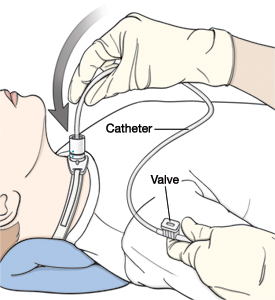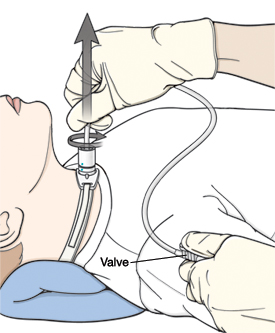When Your Child Needs a Tracheostomy: Suctioning
When Your Child Needs a Tracheostomy: Suctioning
In a trach tube, mucus can build up and thicken. As a result, mucus can plug up the trach tube, making it hard for your child to breathe. Regular suctioning of mucus keeps the tube clear. You will be instructed on how to suction mucus to keep the tube clear. You will also be instructed about techniques for cleaning catheters and how deeply to insert them while suctioning. Below are the basic steps. Follow any other instructions you are given.
|
|
Insert the catheter into the trach tube no further than instructed. |
To remove mucus, cover the valve and twirl the catheter as you withdraw it. |
When to suction
Usually, suctioning is done just before changing and cleaning the trach tube. But you may need to suction more often, depending on your child’s age and the reason for the trach tube. An older child may be able to tell you if he or she feels that suctioning is needed. Here are signs that you may need to suction:
Your child is breathing more quickly.
You hear a whistling or rattling sound when your child breathes.
There are bubbles of mucus at the trach opening or you hear gurgling or rattling sounds as though mucus is present.
Your child is having trouble breathing or eating.
Gathering your supplies
As with cleaning, you may find it easier to set up in the same area each time you do suctioning. Choose a clean, well-lighted space near a sink. It is a good idea to have access to a resuscitation bag, in case of an emergency with the trach. Suctioning supplies include:
Clean, disposable, powderless gloves
Suction machine, tubing, and catheters (you may also use an additional premarked catheter to help guide insertion depth)
Sterile water
Sterile saline solution
Syringe or eyedropper
Sterile or clean cup
Tissues
Setting up your equipment
First explain to your child what you are about to do. Then set up what you will need:
Wash your hands with liquid soap and water. Dry well. You may also use alcohol or disinfectant foam.
Put on gloves.
Attach the catheter to the suction machine. Don’t touch the end that will go into the trach tube.
Turn on the suction machine to 50mm Hg to 100mm Hg.
Pour sterile water into a cup.
Test whether the catheter is working. Dip the tip of the catheter into the sterile water.
Suctioning the trach tube
Below are basic instructions for suctioning. You may have been given additional specific instructions.
Do the following only if your healthcare provider tells you to: Use a syringe or eyedropper to put a small amount (about 1 mL) of sterile saline solution into the trach tube. This helps loosen mucus.
Have your child take a few deep breaths. This may cause your child to cough briefly. This is normal and helps to clear the mucus.
Insert a catheter gently into the trach tube as far as you’ve been instructed to do. (Insertion depth depends on the size of your child and the length of the trach tube.)
Apply suction by covering and uncovering the suction valve on the catheter.
While twirling the catheter, withdraw it to remove mucus. Do not keep the catheter in place for more than 5 to 10 seconds at a time.
Draw saline from the cup into the catheter to clear it of mucus.
Let your child rest and breathe for 1 to 2 minutes.
Then repeat suctioning until the trach tube is clear and makes no more rattling sounds.
Check the secretions. Notify the healthcare provider if there are any changes in odor, thickness, color, or amount.
Do other steps as instructed. For example, you may also suction your child’s nose and mouth. Or you may need to give extra oxygen (do this only if instructed).
Cleaning up
When you have finished suctioning:
Turn off the machine.
Throw away the saline and gloves.
Follow equipment supplier directions for how to clean the suctioning machine and how often.
Making suctioning easier for your child
Suctioning can produce a gagging sensation, which can be scary to your child. Tell your child that this is normal. It may also help to do relaxing activities beforehand. Let your child rest in between suctioning. And don’t suction for any longer than your child can hold his or her breath. The whole session should last no more than 5 to 10 minutes.
Call the healthcare provider
Contact the healthcare provider right away if your child has any of the following:
Red, painful, or bleeding stoma
Yellow or green, smelly, bloody, or thick mucus from the stoma
Fever of 100.4°F (38°C) or higher, or as advised by your healthcare provider
Swelling around the trach tube
Pain when you suction the trach tube
Shortness of breath or any trouble breathing
Vomiting
Trach tube or suction catheter that is difficult to insert
Updated:
August 16, 2018
Sources:
Overview of Tracheostomy, UpToDate, Tracheostony Care: An Evidence -Based Guide to Suctioning and Dressing Changes. Nance-Floyd B. American Nurse Today. 2011, is. 6, ed. 7, pp. 14-16.
Reviewed By:
Fetterman, Anne, RN, BSN,Mancini, Mary, MD,Image reviewed by StayWell medical illustration team.

